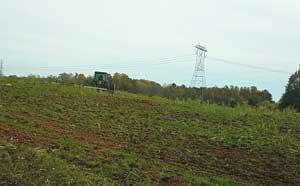Welcome!

ENRICH THAT SOIL — This farmer tills under a crop planted just a couple of months earlier, a crop not meant for harvesting but to create some ‘green manure.’
Garden column: Give me some of that green manure
Recently turned soil has an unmistakable aroma. It is almost umami-like. It drifts through the cool fall air and settles warmly at the back of the throat. Without seeing it, you know it is has rich reddish-brown hue. Without touching it, you know it is soft and yielding.
Like many aromas, the scent of newly turned soil can instantly bring back memories, regardless of whether you used to garden or still do or never really caught the gardening bug. It’s the inviting smell of the soil you turned as you dug worms to go on a long-awaited fishing trip with a favorite adult. It’s the fragrant earthiness that rose from the flower bed as you learned to plant your first tulip or tomato plant. It is that undeniable odor that accompanied your explorations as a child, looking for buried treasures or lost dinosaur bones.
Best of all for a harried society, it’s a reminder to stop and linger for a moment and consider simpler times and our ancient connection to the earth.
Of course, for farmers like the one in the accompanying picture, turning soil at any time of the year is a practical exercise. In this case, the farmer is tilling under a green crop or “green manure.” The cover crop he put in roughly two months ago was barely hip-high but it was never meant to produce a crop for harvest.
In this case, the harvest is actually the nutrients that are being returned to the soil. The acreage around where I live is heavily cultivated. Each year, the crops rotate through from winter wheat to corn or occasionally soybeans. While the folks who work this acreage regular apply manure from their dairy operation and commercial fertilizers, it’s always a good idea to boost the general health of the soil by adding some green instead of constantly taking it all away.
Some readers may have heard of farmers planting clover as a cover crop. Clover is an excellent plant for improving the condition of farm soil. It protects the land from erosion and puts nitrogen back into the ground. But clover isn’t the only cover crop option.
According to the N.C. Cooperative Extension Service, cover crops can be tailored to reach specific goals. Cover crops feed good micro-organisms in the soil that help to make nutrients more available to subsequent crops. If a soil is hard, cover crops with strong root systems like clover and buckwheat can help break it up.
You might say, this is all well and good but do I need to be planting a cover crop in my little garden space? And how am I supposed to turn in a bed of clover with my tiny tiller or shovel?
The answer to the first question is, yes, any garden plot can benefit from a cover crop. And the solution to the second question is — don’t plant clover.
A perfectly acceptable and easily turned cover crop is mustard greens (Brassica nigra). Mustard greens are easy to work into the garden when you are ready. As an added benefit, mustard greens can help control soil-borne diseases as they decompose. Plus, there’s no law that says you can’t enjoy harvesting the greens over the season until it comes time to plow them under.
If you seed a plot now, you can still get a stand of greens before the truly cold weather sets in this January. The seed germination might be slow but it will happen.
Of course, this does require some planning on your part. Cover crops should be turned under and allowed to decompose for any benefit to accrue to the soil. This means you need to plow up (or shovel under) your mustard green plot in March to enjoy the benefits when you plant in April and May.
So, before you head off to buy your Thanksgiving turkey or scout for your Christmas, tuck your vegetable garden in for the winter with a covering of greens. You’ll get to enjoy some tasty fresh greens with your New Year’s Day dinner and your 2022 vegetables will feast of the bounty for the next growing season.
* JD Walker is an award-winning journalist and magazine editor with over two decades of experience covering business, government, health, lifestyles and gardening topics. She lives in Randolph County and divides her time between writing, gardening, eating good food, drinking good wine and catering to one spoiled rotten dog and two skittish cats.
